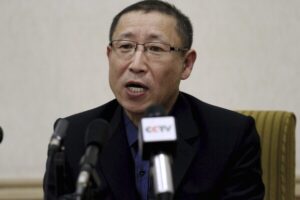Joe Biden on Tuesday outlined a $2 trillion four-year plan to create economic opportunities and strengthen infrastructure through investments in clean energy technologies.
Speaking in his hometown of Wilmington, Del., the presumptive Democratic presidential nominee announced a plan that would increase the use of clean energy in the transportation, electricity and building sectors. His campaign is calling the plan “the largest mobilization of public investment since World War II.”
The proposal sets a goal to cut the nation’s carbon footprint in half by 2035 and keeps Biden’s 2050 timeline to achieve a 100% clean energy economy with net-zero emissions. It also sets out to upgrade four million buildings over four years to meet the highest standards for energy efficiency.
Biden’s plan exemplifies the former vice president’s willingness to expand upon the more modest proposals he had put forth in the Democratic primaries in light of the coronavirus pandemic’s effects on the nation’s health and economy. It’s release comes a week after a joint task force on climate chaired by Rep. Alexandria Ocasio-Cortez (D., N.Y.) and John Kerry, the former senator, secretary of state and 2004 Democratic presidential nominee proposed eliminating carbon pollution specifically from power plants by 2035.
The new plan dramatically accelerates Biden’s initial promises to devote $1.7 billion to green spending over 10 years.
In his speech, Biden also drew connections between environmental advocacy and racial justice, saying that pollution and other toxic harms disproportionately affect communities of color. He proposed establishing an office of environmental and climate justice at the Justice Department and set a goal for disadvantaged communities to receive 40 percent of his plan’s clean energy and infrastructure benefits.
Natural Resources Defense Council Action Fund CEO and president Gina McCarthy told NBC Newsthat Biden’s plan is “by a long shot is the most ambitious we have ever seen from any president in our nation’s history.”
The former vice president says his four-part “Build Back Better” plan would create millions of new union jobs across the auto industry, transit, power sector, buildings, housing and innovation. The plan is part of the campaign’s effort to increase voter confidence in Biden’s ability to handle the economy, an area in which voters say they favor President Trump.
Biden used his speech to attack Trump over his handling of the coronavirus pandemic and held his new plan in contrast with what he noted as a series of failed promises of infrastructure plans since Trump’s 2016 campaign.
“Seems like every few weeks, when he needs a distraction from the charges of corruption of his staff or the conviction of high-ranking members of his administration and political apparatus, the White House announces, quote, ‘It’s infrastructure week,’” Biden said. “How many times have you heard him say that? But he’s never delivered. He’s never even really tried. I know how to get it done.”33
The campaign has not revealed the total cost for Biden’s economic plans, though a senior campaign adviser told NBC News that the campaign would include most of the proposals in an economic stimulus to address the coronavirus pandemic that Biden hopes Congress would pass if he were elected president.
Other pieces of the plan could be paid for by reversing Trump’s tax bill and passed through executive order or legislation, the adviser said.




